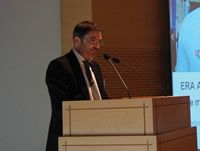Opening proceedings, ERA president José María Camacho, CEO of CirclePrinters, noted the ongoing decline in print runs, even for flagship magazines, most of which are printed gravure. For this reason, publication gravure remains under pressure, with overcapacity, despite plant closures.
And in his keynote address, Christoph Müller of KBA explained developments in the market for publication presses. The decrease in print advertising – mainly affecting newspapers, magazines and catalogues – has led to lower volumes in publication printing in traditional markets such as Europe and North America. In total only 20 publication web presses were sold worldwide in 2014, compared to previous figures of 60 presses from one supplier alone.
Although digital printing is gaining market share, particularly in books and direct mailing, traditional printing technologies such as gravure will remain dominant for the time being, concluded Christoph Müller.
An exceptionally successful case of publishing with paper and print was presented by Michael Bergmeister of the Austrian Red Bull Media House that presently publishes four printed titles, of which the gravure-printed Red Bulletin magazine is the flagship with a worldwide presence. Focusing on lifestyle and sports, it’s the fastest growing men’s magazine, with 2.2-million copies in five languages distributed throughout Western Europe, the US, Mexico, Brazil, South Africa and New Zealand.
Apart from subscriptions, newsstands and supermarkets, distribution channels include universities, high street stores, airport lounges and inserts in national newspapers.
‘The future of print’ was discussed by Sebastian Heinzel of Austria’s Heinzel Group, which produces paper for publication printing at its Laakirchen mill. He referred to the fundamental changes in communication brought about by smartphone, tablets and social media. As advertising spend on the internet and mobile media grows, there’s increased pressure on print media, resulting in lower paper consumption for classic print media such as newspapers, magazines and catalogues, although partly substituted by the retail segment’s supplements and flyers.
Altogether graphic paper demand will decline by 40% by 2020 compared with 2008, he predicted. But there are also encouraging signs for paper and print, eg ads for luxury products can only be effective in print, and innovations combining print and online could ensure the future of paper and print.
An ‘Overview on gravure publication, packaging and security printing’ was provided by Dr Giancarlo Cerutti whose company’s restructure has been concluded. Cerutti is supplying a press to a security printer in the UK that will print the new series of £5 and £10 banknotes on a polymer substrate, making counterfeiting more difficult. In packaging, Cerutti has supplied over 20 presses worldwide despite political turbulences in the Middle East and Eastern Europe. In publication gravure, CTP in Durban, South Africa, started production on its new Aurora press in September. The Aurora press can print 100 000 copy jobs in an economical way, meeting today’s requirements for a publication press.
Josef Aumiller of manroland presented perspectives of web offset printing. Owing to structural changes in printing markets, deliveries of commercial web offset presses have dropped by some 50% since 2010, he told delegates, but manroland has reacted by offering a greater variety of page and signature formats, with four, five or six pages per cylinder circumference, and twin folders allowing both short-grain and long-grain production on the same press. Automated job changeovers and inline control systems speed up production and provide greater consistency in quality through the print run than offset could previously achieve. Hybrid offset/digital solutions are now foreseen for newspaper production, where the digital portion isn’t merely lottery codes and addresses but includes breaking news.
Gravure guarantees highest quality say brand owners
That gravure guarantees the highest quality for brands was confirmed by a GfK study, the results of which were presented in Dresden.
This second ERA conference, attended by 120 participants from packaging and decorative gravure printers, engravers and the supply industry, also explored innovations in print and prepress technology.
A major theme was brand owners’ demands. Anton Kozka from the market research institute GfK presented the results of the latest study, which shows that print volume and price are the most decisive criteria for brand owners in choosing a print process. They see gravure as the print process that guarantees highest quality, and as the ideal process for high volumes.
On the other hand, flexography is regarded as a process for medium volumes, offering medium but acceptable quality. Digital printing only plays a role for very short runs.
The study also confirms the ongoing tendency towards more frequent design changes and smaller volumes, which favours flexible and fast print processes. That gravure continues to meet these requirements is shown by the continuous innovation and efficiency increases in prepress and press make-ready in the gravure process over recent years.
The demands of packaging buyers were also discussed by Werner Thiele of ColoReal, a Swiss consultancy that works closely with international brand owners. He explained that over 40% of brands are ‘burn-out brands’ that will disappear or be replaced. Emotion is a key factor in consumers’ purchasing decisions, but only established brands generate emotion. Some established brands change their well-known appearance by going ‘green’ to promote their environmental friendliness, but this might affect brand loyalty. Generally, success over decades is shown by brands that stick to their recognisable appearance. Concerning the printing process he mentioned that eight out of ten brand owners prefer gravure.
Dr Christopher Kauczor of recently-merged company BST Eltromat spoke about in-line spectral colour management that provides reliable data throughout the entire print run. Cooperation with X-Rite gives compatibility with the measuring instruments used in design and prepress houses, and the system can operate at web speeds up to 800m/min.
Stephan Doppelhammer of QuadTech continued the theme of in-line colour management, stressing the need to calibrate all measurement systems. A special feature of the QuadTech solution is an interface to the Huber ink mixing system, so that spot-colour inks can be prepared and adjusted as required.










